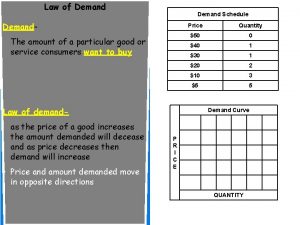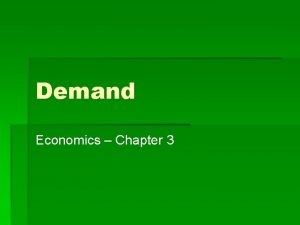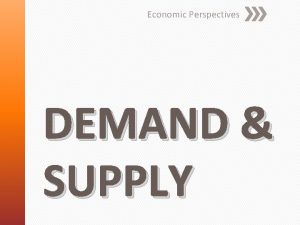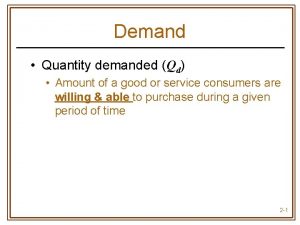DEMAND Demand is the amount of a good














- Slides: 14

DEMAND Demand is the amount of a good that buyers are willing and able to buy, given a set of prices during a specified period of time.


The Demand Curve: The Relationship between Price and Quantity Demanded The demand schedule is a table that shows the relationship between the price of the good and the quantity demanded.

Market Demand versus Individual Demand Market demand refers to the sum of all individual demands for a particular good or service. Individual demand is the amount of product one consumer is willing and able to buy given a set of prices, during a period of time.

DEMAND The law of demand states that, other things equal, the quantity demanded of a good falls when the price of the good rises.

The Demand Curve: The Relationship between Price and Quantity Demanded Demand Curve The demand curve is a graph of the relationship between the price of a good and the quantity demanded.

Shifts in the Demand Curve Change in Quantity Demanded Movement along the demand curve. Caused by a change in the price of the product.

Changes in Quantity Demanded Price of Ice. Cream Cones B 2. 00 Implementation of Evat that raises the price of ice-cream cones results in a movement along the demand curve. A 1. 00 D 0 4 8 Quantity of Ice-Cream Cones

Shifts in the Demand Curve Change in Demand A shift in the demand curve, either to the left or right. Caused by any change that alters the quantity demanded at every price.

Shifts in the Demand Curve Consumer income Prices of related goods Tastes Expectations Number of buyers

Figure 3 Shifts in the Demand Curve Price of Ice-Cream Cone Increase in demand Demand curve, D 3 0 Demand curve, D 1 Demand curve, D 2 Quantity of Ice-Cream Cones Copyright© 2003 Southwestern/Thomson Learning

Shifts in the Demand Curve Consumer Income As income increases the demand for a normal good will increase. As income increases the demand for an inferior good will decrease.

Consumer Income Normal Good Price of Ice. Cream Cone 3. 00 An increase in income. . . 2. 50 Increase in demand 2. 00 1. 50 1. 00 0. 50 D 1 0 1 2 3 4 5 6 7 8 9 10 11 12 D 2 Quantity of Ice-Cream Cones

Shifts in the Demand Curve Prices of Related Goods When a fall in the price of one good reduces the demand for another good, the two goods are called substitutes. When a fall in the price of one good increases the demand for another good, the two goods are called complements.
 Zoroastrianism beliefs
Zoroastrianism beliefs Como te llamas in spanish
Como te llamas in spanish Hi good morning
Hi good morning Hello teacher good afternoon
Hello teacher good afternoon You are good when theres nothing good in me
You are good when theres nothing good in me Công thức tính độ biến thiên đông lượng
Công thức tính độ biến thiên đông lượng Thế nào là mạng điện lắp đặt kiểu nổi
Thế nào là mạng điện lắp đặt kiểu nổi Sự nuôi và dạy con của hươu
Sự nuôi và dạy con của hươu Các châu lục và đại dương trên thế giới
Các châu lục và đại dương trên thế giới Dạng đột biến một nhiễm là
Dạng đột biến một nhiễm là Biện pháp chống mỏi cơ
Biện pháp chống mỏi cơ Bổ thể
Bổ thể độ dài liên kết
độ dài liên kết Thiếu nhi thế giới liên hoan
Thiếu nhi thế giới liên hoan Hát lên người ơi
Hát lên người ơi



























